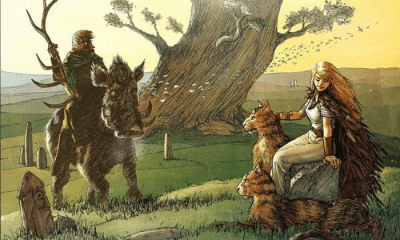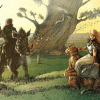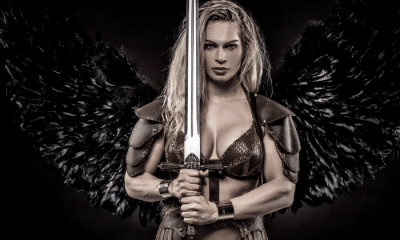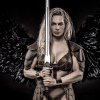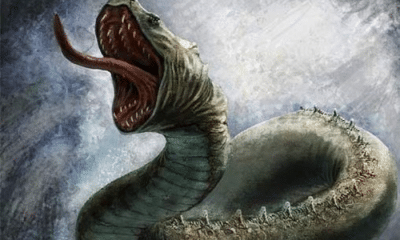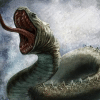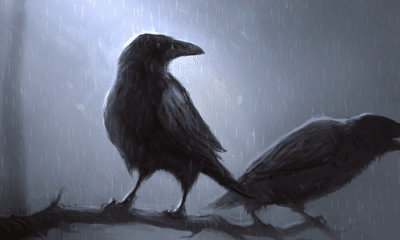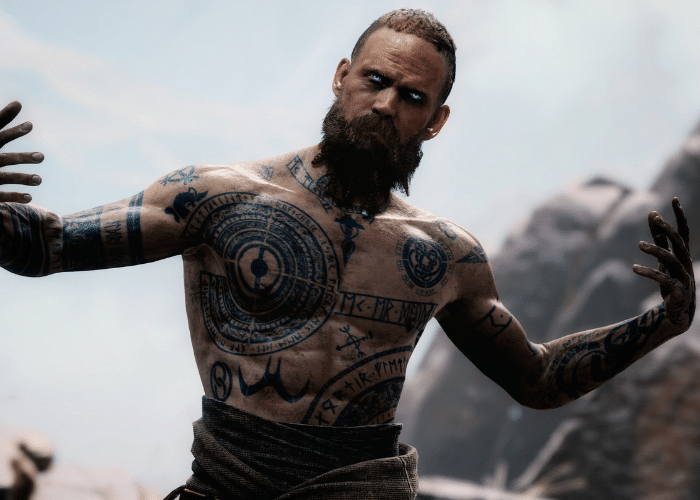
Norse
Who Was Baldur in Norse Mythology?
Who Was Baldur in Norse Mythology?
Baldur was the fairest and noblest of the Norse gods, but his most well-known story is of his death. Read on to find out why Baldur’s death was so shocking and how it influenced every subsequent story of Norse mythology!
Baldur, also written as Baldr or Balder, was one of Odin’s many sons. He had the distinction of being one of only two sons born into Odin and Frigg’s marriage and, because his brother was blind, the only one capable of living up to the ideals of Norse godhood.
Baldur not only met these ideals, but he also exceeded them. His amazing wisdom, beauty, radiance, and fairness made him the most beloved and honored of the gods.
Not everyone loved Baldur, however. The trickster Loki conspired to have Baldur killed in one of the most well-known stories of Norse mythology.
Baldur’s death was not a stand-alone story. Every event that took place afterward could be seen as a reaction to this terrible crime, including the great battle of Ragnarok.
In the buildup to the final battle of the gods, the murder of Baldur was the event that caused everything afterward to happen, including the end of the world.
Baldur the Fair
Like many of the Norse gods, Baldur did not have a specific domain or set of powers.
Instead, he was described primarily by his attributes. These showed that Baldur was one of the most noble and well-loved gods of the Norse pantheon.
His name is usually translated as “Brave” or “Heroic,” and Baldur was said to be exceptional in these regards. The Prose Edda describes him as “the best” of the Aesir as claims that “all good things are said of him.”
Like many gods, Baldur was described as white, gleaming, and shining. While this was a common trait of the gods, it seemed to have been particularly notable for Baldur.
His home, Breidablik, was said to be so pristine that no dirty thing could exist there. Wild chamomile was compared to Baldur’s brow because it was such a stark shade of white.
While many gods gleamed with divinity, Baldur was so exceptional that light shone from him.
His fairness in form was reflected in his fair judgment and behavior.
Baldur was so wise, well-spoken, and gracious that no one ever questioned his judgments. He was an ultimate authority in right and wrong because his very form showed the fairness of his thought.
He was also exceptional in his physical prowess. He was an excellent fighter, skilled with every weapon, and even had a ship, Hringhorni, that sailed faster and truer than any other ever created.
Every aspect of Baldur’s life reflected his exceptional virtue. His wife, Nanna, was the goddess of peace and joy and their son Forseti was second only to his father as a judge and mediator.
Baldur was so radiant and good that he was loved by every living thing in every world. Only one being ever showed any animosity toward Baldur.
The Death of Odin’s Son
When Odin went to the land of the dead in search of prophecy, he learned things that influenced every decision he made afterward. Although he and the other gods tried to avoid the fate of Ragnarok, each time they tried to prevent its arrival seemed to move them closer to it instead.
One of the most disturbing things Odin learned was that one of the precursors to Ragnarok would be the death of his beloved son, Baldur.
This confirmed a dream that had haunted Baldur in which he saw his own death. No one knew, however, exactly how he would be killed.
When Odin shared what he had learned, he and his wife Frigg were determined to prevent Baldur’s death. Even if it did not prevent Ragnarok, neither could bear the idea of losing their most well-loved son.
Odin had been told that Baldur would be murdered, so Frigg set out on a mission to ensure that no harm could come to him.
She spoke to every god, human, and every member of every other race in the Nine Worlds. Every one of them swore that they would never harm her son.
She then asked every animal, plant, stone, metal, element, and even the ground itself to swear that they would not harm Baldur. The oath was taken by everything in every world, she believed.
There was one living thing, however, that did not take the oath to keep Baldur safe. When she asked the mistletoe, it refused to swear.
Frigg thought nothing of this because it was such a small and insignificant plant. What she did not know what that the humble mistletoe was actually the trickster Loki in disguise.
The other gods, learning that nothing could harm Baldur, soon made a game of his invincibility. They threw stones, branches, weapons, and even animals at him and laughed as everything swerved to avoid hitting his shining body.
One god, however, could not join in this entertainment. Baldur’s brother Hodr was blind, so he could no see to throw anything at his sibling.
Loki appeared and offered to help Hodr join in the game. He gave the blind god his bow and aimed an arrow for him to shoot.
Hodr, however, did not know that Loki had made the arrow from mistletoe. The small bush, the only thing in the world that could harm Baldur, became a deadly weapon.
Loki aimed the arrow but Hodr fired the fatal shot. Baldur died in seconds at his brother’s hand.
According to some sources, Odin had time to whisper something in his son’s ear in his last moments. What the god told his dying son, however, remained a mystery.
In desperation, Odin sent a messenger to Hel to beg for Baldur’s release. Hel agreed that he should return to Asgard unharmed if he were truly as beloved as the gods claimed.
To prove this, Hel demanded that every living thing should weep in mourning for the lost god. Frigg and the other gods again went through all the Nine Worlds on Baldur’s behalf.
Every creature with eyes shed tears when they learned of Baldur’s death. Trees wept sap and even rocks squeezed out droplets of water.
When they went to Jotenheim, however, one giantess refused to weep. Thokk, who lived in an isolated cave, claimed no love for Baldur or any other god and proclaimed that Hel should keep what she had taken.
Thus, there was no way to release Baldur from Hel. The gods resigned themselves to the loss and prepared for his funeral.
Baldur’s body was placed on his great ship and set ablaze. It was joined by that of his wife, Nanna, who had died of grief at the thought of being separated from her husband.
Avenging Baldur
The gods held Baldur’s funeral, but they were not entirely resigned. Odin, in particular, was filled with thoughts of revenge.
This was amplified when the gods learned the truth about Baldur’s death.
Loki, who had once been a dear friend of Odin and the other gods, had fallen out of favor. His tricks had become more cruel and even the most patient gods tired of his selfishness and destruction.
By the time Aegir hosted the gods at a feast, there was suspicion that Loki had been involved in Baldur’s death. The gods knew that he had aimed the fatal arrow, but his words soon confirmed his full involvement.
When he entered the hall, Frigg told him that if she still had a son as brave and strong as Baldur the trickster would be killed on sight. Loki responded by mocking the goddess’s loss.
You must want me
to recount even more
of my mischief, Frigg.
After all, I’m the one
who made it so that Balder
will never ride home again
-Poetic Edda, Lokasenna (trans Crawford)
The gods then knew what they had suspected. Loki had known the mistletoe would kill Baldur.
There was also evidence that Thokk, the giantess who refused to mourne the god’s death, had been another of Loki’s many disguises. He had not only killed Baldur, but also ensured that he would remain in Hel.
After the feast, the gods decided that the time had finally come to truly punish Loki for his crimes. As they began to search for the trickster, who had gone into hiding after Thor arrived at Aegir’s hall, Odin set his full plan for revenge in motion.
That day, the giantess Rindr gave birth to Odin’s youngest son, Vali. This new god was born with the sole purpose of avenging Baldur’s murder.
Vali grew to manhood on the same day that he was born. By nightfall, he was strong enough to kill Hodr.
Although Hodr had meant no harm, Odin’s laws still held him culpable for Baldur’s death. Hodr joined his brother in Hel and his actions were so hateful that few even spoke of him again.
Vali joined the other Aesir gods just as they captured Loki, who had tried to hide by changing into a fish. When the gods dragged the trickster to a remote cave, Vali was able to take his final revenge.
Vali transformed into a wolf and tore Loki son Nari to pieces. The gods then used their magic to change Nari’s entrails into strong chains that would bind Loki to the rocks.
To complete his punishment Skadi, whose father had been killed as a result of one of Loki’s tricks, placed a serpent above his head. Its fangs dripped burning venom into his face, causing him to scream in pain.
Loki’s wife did her best to catch the venom in a bowl, but whenever she had to empty her vessel he was burned again. Loki would remain bound and tortured in vengeance for Baldur’s death until Ragnarok.
The God’s Brothers
Baldur’s death was one of the major events that sent into motion the events of Ragnarok.
While other gods had died or been hurt before, Baldur’s death was the most permanent. It was also the most painful because he was so well-loved.
Baldur was loved, as the legend shows, by every living thing because of his beauty, righteousness, and kindness. Among the Aesir, however, he also held a particularly privileged position.
Baldur and Hodr were the only sons named to both Odin and Frigg. They had many half-brothers, however, who had been born to Odin’s various mistresses.
This meant that a large percentage of the Aesir were directly related to Baldur and mourned him not just as a fellow god, but also as a brother. In fact, all of Baldur’s brothers would be directly named in the stories of the events that followed Baldur’s death.
- Thor – Odin’s most war-like son was the only god Loki truly feared. He threw Loki out of Aegir’s hall, then helped to capture and bind him. At Ragnarok, he would fight Jormundgandr, one of Loki’s children.
- Heimdall – He was only named as Odin’s son in some sources, but his connection to avenging Baldur seems to strengthen the claim of kinship. During Ragnarok, he would be the one to fight and kill Loki to fully avenge Baldur’s death.
- Tyr – By the time of Aegir’s feast Tyr had already lost a hand to bind Fenrir, the giant wolf that was one of Loki’s children. At Ragnorok he would battle the dog of Hel, Loki’s daughter.
- Vali – Born to avenge Baldur, he would kill both Hodr and one of Loki’s sons in one day.
- Vidarr – Odin’s youngest son was born to avenge his father’s inescapable death. After Odin’s death in battle against Fenrir, Vidarr would overpower the wolf and kill Loki’s most vicious child.
- Hermod – Although rarely featured in other stories, it was Hermod who traveled to Hel as Odin’s messenger after Baldur’s death. He brought back Odin’s ring which Baldur had worn in death.
- Bragi – The god of poetry was the first to express his hatred for Loki. At Aegir’s feast, Bragi declared him unwelcome.
This meant that a large percentage of the Aesir were directly related to Baldur and mourned him not just as a fellow god, but also as a brother.
Following Baldur’s death, his half-brothers were the principal gods named in Loki’s capture and the binding of both him and his children.
Ragnarok would begin when Loki and his children broke free of their restraints and joined together to assault Midgard. In this, too, Baldur’s brothers would play key roles.
Ragnarok can be read as the final step in avenging the death of Baldur and the crimes of Loki. Only one of the gods named as part of the battle, Freyr, is not a direct relative of the fallen god and he is also named as the god who would not fight a monster connected to Loki.
Baldur Reborn
Many of Baldur’s family members would die at Ragnarok.
Odin, his father, would be killed in battle against Fenrir. Thor would die from Jormungandr’s venom, Heimdall would be killed by Loki, and Tyr would fall against Hel’s hound.
Loki and his forces would be killed, but the cost would be high. By the end of the battle, only two members of Odin’s family would survive.
Of his many sons only the youngest, Vali and Vidarr, would live through Ragnarok. The gods who had been bor specifically to fight for vengeance would fulfill their duties and rebuild Asgard.
They would not be alone, however. A handful of other gods would join them who were not named in the battle, including Njord, Hoenir, and Thor’s sons Modi and Magni.
When these surviving gods met in the remains of Asgard, they would be joined by two members of the pantheon that were thought to have been lost forever.
When Ragnarok began, the gates of Hel’s realm would be broken open and all its inhabitants would pour into Midgard. These were mostly the wretched dead who fought for Hel and Loki’s cause, but also the gods who had been killed before the battle was joined.
Baldur and Hodr would be reborn and immortal once more. They would join their surviving peers where Asgard had once stood.
The two would be reconciled. One poem claimed that they would sift through the dirt and ashes of Asgard to find the game pieces that they had once played with together.
The surviving gods would join together to create a new pantheon without the previous division between the Aesir and Vanir. Most sources implied that Baldur and Njord together would lead the new pantheon as gods of law and justice.
Historicizing the Myth
The myth of Baldur is a well-known story of gods, magic, and the supernatural. At least one attempt was made, however, to fit it into real-world history.
The Gesta Danorum was a book written in the 12th century. Saxo Grammaticus, who worked for a Christian archbishop, wrote in Latin to create the first comprehensive history of Denmark and the Danes.
Saxo’s history, however, often mixed fact with legend. In addition to documented history, he wrote about the heroes and gods of Norse tradition.
The Gesta Danorum included kings and heroes of an imagined Germanic past that were clearly inspired by the stories of Norse gods. Saxo stripped them of their traditional supernatural powers and imagined rationalizations for how their legends could have taken place in the real world.
One of the stories given this treatment by Saxo was that of Baldur. Giving him the Latinized name Balderus, the writer imagined that he had been a king who was renowned for his commitment to justice and honor.
Balderus, he imagined, was a demigod or particularly blessed instead of being a god himself. Because of this, weapons made of common iron were not strong enough to pierce his flesh.
According to Saxo, Balderus and his brother Hotherus had vied for the hand of Nanna, the Norwegian king’s daughter. The two fought and, despite Balderus’s abilities and the help of Odin and Thor, Hotherus won and married Nanna.
Balderus was brave, however, so he met Hotherus again in battle. This time, Hotherus was armed with a magical sword called Mistletoe that was able to mortally wound Balderus. After three days, Balderus died and was buried with honors.
Saxo’s story, like many of his other “historical” tales, did not completely Christianize the myths. Instead, they maintained the status of the most important gods but made many other characters mortals who had a connection to Denmark and its throne.
Other contemporary writers went further, seeking to completely strip the pagan stories of their supernatural, non-Christian connotations.
The Chronicon Lethrense claimed that all the Norse characters were kings and warriors who had been incorrectly identified as gods. Odin, called Othen in the Chronicon, was a human king of exceptional renown but with no magical powers.
Othen’s son, the book says, was named Balder. He was killed in battle by a Saxon ruler called Hother. Othen fled until another of his sons, Both, avenged his brother and killed Hother.
These stories show how powerful Baldur’s story was in the Norse world. Even after the decline of the Norse religion, he was seen as such a regal figure that attempts were made to rationalize him as a living king.
The Ripple Effect of Baldur
In Norse mythology, Baldur was one of the many sons of Odin. He was lauded as the most fair, wise, kind, and beautiful of the Aesir gods.
When Baldur dreamt of his own death, his father traveled to Hel to receive the wisdom of a seeress. It was revealed that Baldur would be killed, although neither the dream nor the prophecy detailed the manner of his death.
To keep him safe, his mother Frigg made every living thing, substance, and element swear to do him no harm. Only mistletoe, an insignificant plant, refused.
Loki knew this, however, and made an arrow out of mistletoe. He tricked Baldur’s blind brother Hodr into firing the arrow that took Baldur’s life.
Hel agreed to release Baldr to live again if every living thing mourned him. One giantess, Loki in disguise, refused, so Baldur was lost forever.
Loki’s actions made him a lasting enemy of the gods. The repercussions of Baldur’s death would bring the world close and closer to Ragnarok.
The final battle of the gods can be viewed as the last act in avenging Baldur’s death. His father and brothers are the major participants in the battle and each faces off against an enemy with a personal connection to Loki.
Loki and his children would die in Ragnoroke, as would many of the gods. Baldur and Hodr would both be free to leave Hel’s realm at last and rejoin the survivors of Ragnarok to lead a new pantheon of just and fair gods.


